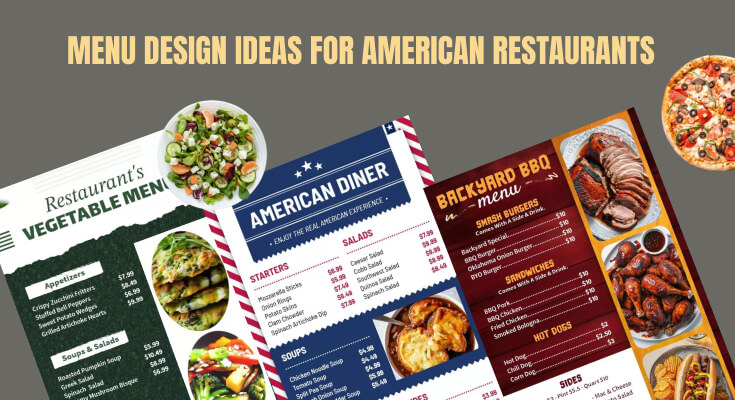Are you planning to start a restaurant or food business, and looking for printable menu design ideas for American restaurants? You’re on the right page.
Your menu design plays a crucial role in shaping the customer experience, driving sales performance, and establishing brand identity. Furthermore, printable menu design has become increasingly important as restaurants adapt to changing consumer preferences and operational needs.
In today’s competitive restaurant industry, menu design directly impacts your bottom line. Additionally, a well-designed printable menu serves multiple purposes: it guides customer choices, reflects your brand personality, and ultimately drives revenue.
Before we explore the ideas, let’s understand why you need to focus on design first.
Why Does Printable Menu Design Matter for American Restaurants?
The Psychology Behind Menu Design
Menu psychology significantly influences customer behavior and purchasing decisions. Research shows that customers typically spend only 109 seconds reading a menu before making their choice. Consequently, your printable menu design must capture attention quickly and guide customers toward profitable items.
Moreover, the strategic placement of items, color choices, and typography all impact how customers perceive your restaurant. For instance, highlighting signature dishes or high-margin items through design elements can increase their selection rate by up to 30%. Therefore, investing in professional printable menu design pays dividends in increased sales.
Current Trends in American Restaurant Menus
American restaurants are embracing several key trends in printable menu design:
- Minimalist layouts that reduce decision fatigue
- Local sourcing callouts to attract conscious consumers
- Dietary restriction icons for allergen awareness
- QR code integration for digital menu access
- Write a good menu description to showcase fresh ingredients
Additionally, many restaurants now create multiple versions of their printable menus for different occasions, such as lunch specials, dinner menus, and catering options.
What are Menu Design Ideas and Examples for American Restaurants?
Below are some menu design ideas and examples that may help you design a printable menu for your American restaurant. We’ve shown a design idea for different approaches, like a drink menu, BBQ, breakfast, fast food, and other menus.
1. Classic American Diner Menu
If your restaurant is a nostalgic American diner, you’ll want your menu design to reflect the timeless feel of the 50s and 60s. Classic diner menus are often simple yet charming, with bold typography, bright colors, and a clean layout.
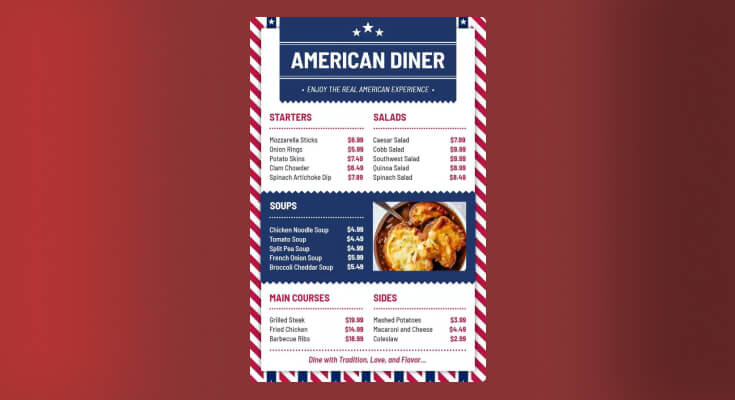
Design Elements:
- Bold Colors: Use red, white, and black as your primary color palette, as these are classic diner colors that evoke feelings of comfort and nostalgia.
- Retro Fonts: Opt for fonts that mimic old-school diner signs, such as serif or slab fonts. Popular fonts like “Bebas Neue” or “Lobster” can give a retro feel to the text.
- Icons and Graphics: Consider adding graphics like burger icons, milkshakes, and fries to represent classic diner fare.
- Simple Layout: Keep the layout straightforward. Organize the menu items into categories like “Breakfast,” “Burgers & Sandwiches,” “Sides,” and “Drinks.”
Customization Tips:
- Add a Personal Touch: Include a “Chef’s Special” or “Local Favorites” section to showcase popular or unique offerings.
- Vintage Border: Frame your menu with a vintage-style border to enhance the retro look.
2. Farm-to-Table Bistro Menu

For American bistros or restaurants focusing on fresh, locally sourced ingredients, a farm-to-table menu should reflect simplicity, organic vibes, and rustic charm.
Design Elements:
- Natural Colors: Use earthy tones such as greens, browns, and warm yellows. These colors symbolize freshness, sustainability, and a connection to the earth.
- Handwritten or Serif Fonts: A handwritten or elegant serif font can evoke a sense of handcrafted quality. Think about using fonts like “Lora” or “Playfair Display.”
- Textured Backgrounds: Consider using textured backgrounds like parchment paper, wood grain, or rustic chalkboard to give the menu a warm, inviting feel.
- Minimalist Design: The menu should be clean, focusing on the names of dishes with brief, appealing descriptions. Avoid overloading the design with too many graphics.
Customization Tips:
- Highlight Seasonal Specials: Incorporate a section for seasonal offerings or “Today’s Fresh Picks” to emphasize the farm-to-table philosophy.
- Add Organic Symbols: Include small, subtle symbols like leaves or farm imagery to further communicate the farm-to-table theme.
3. Contemporary Bistro Menu
For a modern American bistro, you want a sleek, clean, and sophisticated menu design that complements the contemporary style of your restaurant. This design is perfect for urban eateries or trendy establishments offering innovative dishes.

Design Elements:
- Minimalist Layout: Use a minimalistic design with plenty of white space to make the menu items pop. Less is more in modern design.
- Muted Colors: Black, white, gray, and metallic tones (like gold or silver) work well for a contemporary feel.
- Simple, Clean Fonts: Choose sans-serif fonts like “Helvetica,” “Montserrat,” or “Raleway” for a modern touch.
- Icons for Special Diets: If your restaurant offers vegan, gluten-free, or other diet-friendly options, use simple icons to indicate those choices.
Customization Tips:
- Use High-Quality Images: If your menu items look as good as they taste, consider adding high-quality images that complement the modern aesthetic.
- Highlight Signature Dishes: Use a different font or color to highlight your signature dishes or chef’s recommendations.
4. Southern American BBQ Menu
A Southern BBQ menu design should embody warmth, tradition, and hearty comfort food. The design should evoke the rich flavors and history of Southern cuisine. You can explore more BBQ menu designs that will help you craft the perfect one for your restaurant.

Design Elements:
- Earthy, Warm Colors: Use browns, deep reds, oranges, and yellows to represent smoky meats and rich flavors.
- Bold Typography: Bold, blocky fonts like “Impact” or “Bebas Neue” will evoke strength and authenticity.
- Wood or Rustic Backgrounds: A wood-grain or distressed paper background will help create a cozy, welcoming feel.
- Grill and BBQ Graphics: Icons like grills, meat cuts, and smoke clouds can add a fun, thematic touch.
Customization Tips:
- Add a “Sauce Section”: If your restaurant offers different sauces, dedicate a special section to them to tempt your customers.
- Highlight Family Platters: If your restaurant offers family-style platters or large servings, make sure to highlight these options prominently.
5. Fast-Casual Food Menu
For a fast-casual American restaurant, your menu needs to be clear, concise, and appealing without overwhelming the customer. Fast-casual menus often feature quick-service dishes like burgers, sandwiches, and salads.
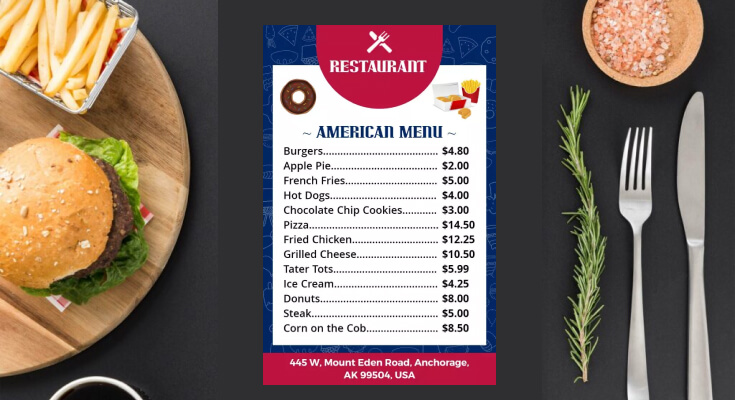
Design Elements:
- Bright and Bold Colors: Colors like orange, red, and green work well in a fast-casual setting as they stimulate appetite and energy.
- Simple, Bold Fonts: Use large, bold fonts for easy readability. Fonts like “Arial,” “Roboto,” or “Montserrat” can make a modern, clean impact.
- Images of Food: High-quality food images can help attract attention and make the dishes more appealing. Focus on close-up shots of your most popular items.
- Category Organization: Keep the menu organized with clear categories such as “Burgers,” “Sandwiches,” “Salads,” and “Drinks.”
Customization Tips:
- Menu Size: Consider offering a double-sided menu, especially if you have a lot of items but still want to keep it compact. Find more details and learn about the menu size here.
- Featured Dishes: Use color blocks or borders to highlight special offers or new items.
6. Sports Bar Menu
A sports bar menu should be fun, bold, and easy to navigate. The design should reflect a casual atmosphere with a touch of excitement and energy.
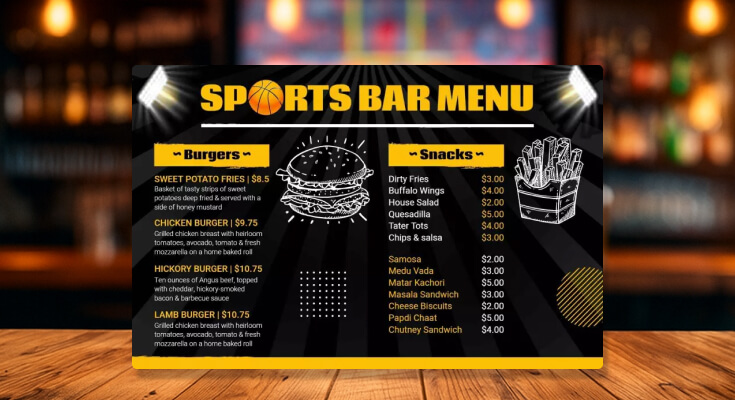
Design Elements:
- Bold and Fun Fonts: Choose chunky, bold fonts that are easy to read from a distance. Fonts like “Impact” or “ChunkFive” work great for sports bars.
- Vibrant Colors: Use a color palette that includes shades of red, blue, yellow, and black, representing excitement, energy, and boldness.
- Icons and Graphics: Add simple graphics like beer mugs, burgers, nachos, and sports-related images to capture the vibe of a sports bar.
- Large Sections: Break the menu into easily identifiable sections such as “Starters,” “Burgers & Wings,” and “Drinks & Specials.”
Customization Tips:
- Highlight Game Day Specials: Feature “Game Day Specials” or “Happy Hour” prominently on the menu.
- Use Fun Language: Consider adding some fun and playful language in the menu descriptions to match the lively sports bar atmosphere.
7. Coastal American Seafood Menu
For restaurants offering fresh seafood and coastal-inspired cuisine, your menu should evoke the relaxed yet vibrant feeling of the ocean. Whether you’re near the coast or simply serving up the freshest seafood, the design should reflect the natural beauty and refreshing taste of the sea.
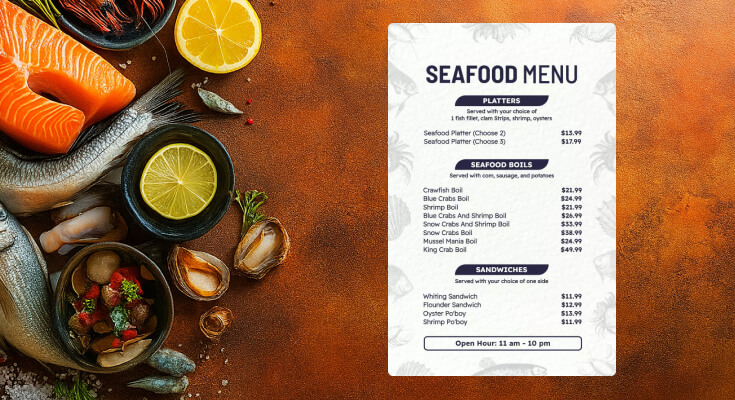
Design Elements:
- Ocean-Inspired Colors: Use shades of blue, turquoise, sandy beige, and seafoam green to reflect the colors of the sea.
- Wave Patterns or Beach Elements: Incorporate subtle wave patterns or imagery like seashells, anchors, or fishing boats to bring in the coastal theme.
- Light, Elegant Fonts: Choose soft, flowing serif or script fonts that resemble the waves. Examples include fonts like “Pacifico” or “Lobster.”
- Natural, Textured Backgrounds: Backgrounds resembling textured linen or sand can give your menu a beachy, relaxed vibe.
Customization Tips:
- Specials and Catch of the Day: Highlight your fresh seafood specials with a separate section labeled “Catch of the Day” or “Ocean Fresh.”
- Icons for Diets: If you offer gluten-free or keto options, include symbols like a fish or a wheat-free icon for easy navigation.
8. Classic American Steakhouse Menu
A steakhouse menu should exude sophistication, strength, and hearty flavors. It’s all about showcasing premium cuts of meat, rich sides, and classic American cocktails. The menu design should reflect the robust and luxurious nature of a steakhouse.
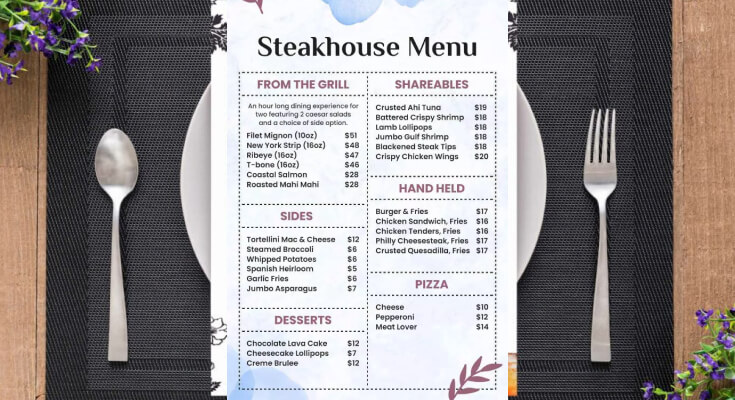
Design Elements:
- Rich, Deep Colors: Use dark tones like deep reds, browns, and blacks, which are associated with the warmth of a steakhouse and the richness of its dishes.
- Elegant Fonts: Opt for serif fonts like “Georgia” or “Merriweather” to evoke tradition and sophistication. A combination of bold headings and fine details will add contrast and elegance.
- Leather or Wood Textures: A leather-bound or wood-grain texture will make the menu feel luxurious and high-end, reinforcing the upscale nature of your restaurant.
- Simple, Bold Imagery: Use minimalistic graphics, like silhouettes of steak cuts or a grill, to keep the design clean and refined.
Customization Tips:
- Premium Cuts Section: Use bold text to highlight your premium steak cuts, and consider adding descriptions about how the steaks are prepared (Aged for 28 days).
- Wine Pairings: Offer wine pairing suggestions under each steak or dish to elevate the dining experience.
9. American Vegan/Plant-Based Menu
With more people turning to plant-based diets, it’s important for restaurants offering vegan or plant-based American cuisine to have a clear and inviting menu. The design should focus on freshness, health, and sustainability.
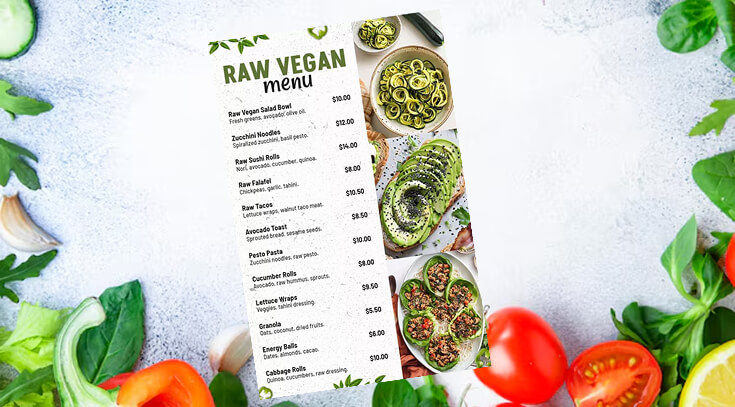
Design Elements:
- Green and Earthy Colors: Green is the natural choice for a plant-based menu, symbolizing freshness and sustainability. Combine it with browns, beiges, and yellows for a wholesome, natural look.
- Modern, Clean Fonts: Use simple, modern fonts like “Helvetica” or “Open Sans” to keep the menu clean and easy to read. If you want a more organic feel, a handwritten font like “Pacifico” can work as well.
- Nature-Inspired Graphics: Incorporate graphics like leaves, plants, or vegetables to highlight the focus on fresh, plant-based ingredients.
- Minimalist Layout: Keep things simple with clear sections, such as “Starters,” “Salads,” “Bowls,” and “Desserts,” to make navigation easy.
Customization Tips:
- Highlight Signature Dishes: If you have a signature dish (like eggs Benedict or a unique pancake stack), feature it at the top of the menu to draw attention.
- Daily Specials: Add a “Today’s Brunch Special” section with a chalkboard-style design for a fresh, daily feel.
10. American Comfort Food Menu
For a comfort food restaurant offering hearty American classics like mac & cheese, fried chicken, mashed potatoes, and meatloaf, your menu should communicate warmth, familiarity, and nostalgia. The design should remind customers of home-cooked meals and make them feel at ease.
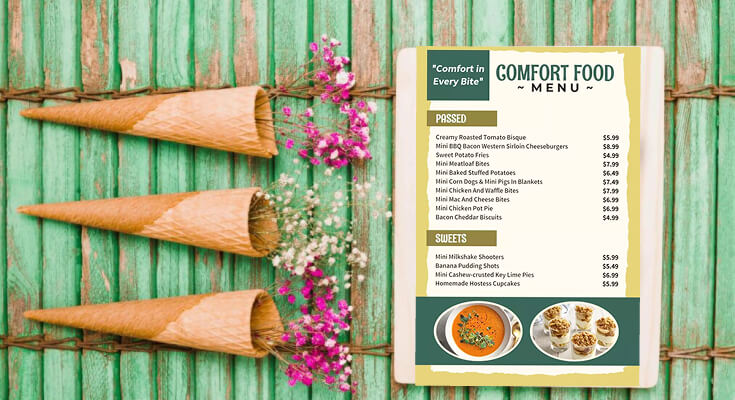
Design Elements:
- Warm, Earthy Colors: Use a combination of orange, red, mustard, and brown shades to evoke feelings of warmth and comfort.
- Rustic Fonts: Choose fonts with a hand-crafted or vintage feel. Consider fonts like “Rockwell,” “Roboto Slab,” or “Amatic SC” for a rustic, homey vibe.
- Country/Classic Imagery: Consider adding illustrations of classic comfort foods or items like rolling pins, spoons, and bowls.
- Distressed or Paper Textures: A worn-out, paper-like texture adds to the rustic, “homemade” feeling.
Customization Tips:
- Offer Family Style Platters: If your restaurant offers family-style portions, make sure to highlight these larger serving sizes prominently.
- Use Fun Section Names: Instead of just “Sides,” call it “Down-Home Sides” or “Grandma’s Favorite Sides” for added character.
Confused, how to make a restaurant menu without hassle, thanks to this free menu maker that helps you create a menu in minutes that delights your customers.
What Are the Essential Elements of Effective Printable Menu Design?
Typography and Readability
Typography forms the foundation of successful printable menu design. First, choose fonts that reflect your restaurant’s personality while maintaining excellent readability. For American restaurants, consider these typography guidelines:
Header fonts should be bold and distinctive, typically 18-24 points in size. Meanwhile, body text needs to be clear and legible, usually 10-12 points. Furthermore, avoid using more than two different font families to maintain visual consistency.
Additionally, ensure adequate contrast between text and background colors. Dark text on light backgrounds typically works best for printable menus, as it reduces printing costs and improves readability under various lighting conditions.
Color Psychology in Menu Design
Colors evoke emotions and influence purchasing decisions. Therefore, strategic color choices in your printable menu design can significantly impact sales performance:
- Red stimulates appetite and creates urgency
- Green suggests freshness and healthy options
- Yellow promotes happiness and optimism
- Brown conveys warmth and comfort food
- Blue should be used sparingly as it can suppress appetite
However, remember that printable menus require colors that reproduce well in print. Consequently, test your color choices across different printing methods to ensure consistency.
Learn more about choosing the perfect typography and color combinations for menu design, and make the menu appetizing.
Layout and Visual Hierarchy
Effective printable menu design uses visual hierarchy to guide customers through their dining experience. Start by organizing menu items into logical categories that align with typical dining patterns. For example, arrange sections in this order:
- Appetizers and starters
- Soups and salads
- Main courses
- Desserts
- Beverages
Additionally, use white space strategically to prevent overcrowding and improve readability. Menu items should have adequate spacing between them, making it easy for customers to scan options quickly.
There are many other factors and essential elements of the restaurant menu design you need to consider while designing a printable menu.
Strategic Use of Photography and Illustrations
Visual elements can dramatically enhance printable menu design ideas when used strategically. However, quality and relevance matter more than quantity:
High-Quality Food Photography: Professional food photos can increase item sales by 30%.
- Use natural lighting for an authentic appearance
- Style food to look fresh and appetizing
- Maintain a consistent photographic style
- Focus on signature dishes and high-margin items
Custom Illustrations: Hand-drawn elements add personality and uniqueness:
- Sketch-style ingredient illustrations
- Whimsical character mascots
- Decorative borders and frames
- Technical drawings of cooking processes
Texture and Pattern Integration
Adding texture and patterns creates visual interest and tactile appeal in printable menu design ideas:
Background Textures: Subtle textures enhance visual appeal without overwhelming content:
- Linen or canvas textures for rustic themes
- Marble patterns for upscale establishments
- Wood grain effects for casual dining
- Concrete textures for industrial concepts
Decorative Patterns: Patterns add visual interest when used sparingly:
- Geometric patterns for modern restaurants
- Floral motifs for garden-themed establishments
- Paisley or damask for elegant venues
- Tribal patterns for southwestern cuisine
How Can You Implement Creative Layout Ideas for Printable Menus?
Innovative Grid Systems
Traditional column layouts work well, but creative grid systems can set your menu apart. Therefore, consider these alternative approaches to printable menu design ideas:
Asymmetrical Layouts: Break away from standard symmetry to create visual interest:
- Offset columns with varying widths
- Diagonal elements that guide the eye
- Overlapping sections for dynamic flow
- Strategic white space for emphasis
Circular and Curved Designs: Curved elements soften harsh lines and create organic flow:
- Circular frames for featured items
- Curved text paths for visual interest
- Spiral layouts for wine and cocktail lists
- Organic shapes inspired by food items
Modular Block Systems: Create flexibility with modular design approaches:
- Interchangeable sections for easy updates
- Consistent block sizes for visual harmony
- Color-coded categories for quick navigation
- Mix-and-match components for seasonal changes
Creative Typography Hierarchies
Typography hierarchy guides customers through your menu systematically. Furthermore, creative approaches to text organization can dramatically improve user experience:
Size Variation Strategies: Use dramatic size differences to create a clear hierarchy:
- Extra-large headers for major sections
- Medium-sized subheadings for categories
- Standard body text for descriptions
- Small text for additional details
Font Pairing Techniques: Combine fonts strategically for maximum impact:
- Pair bold display fonts with clean body text
- Mix serif headers with sans-serif descriptions
- Use script fonts sparingly for special items
- Maintain consistency across similar elements
Color-Coded Information: Different colors can organize information effectively:
- Bright colors for promotional items
- Neutral tones for standard offerings
- Warm colors for comfort foods
- Cool colors for fresh, healthy options
Unique Section Organization Ideas
Standard menu categories work well, but creative organization can improve customer experience. Therefore, consider these innovative approaches to printable menu design ideas:
Journey-Based Organization: Structure menus around dining experiences:
- “Start Your Adventure” (appetizers)
- “The Main Event” (entrees)
- “Sweet Endings” (desserts)
- “Liquid Inspiration” (beverages)
Time-Based Categories: Organize items by dining occasions:
- “Rise and Shine” (breakfast items)
- “Midday Fuel” (lunch specials)
- “Evening Indulgence” (dinner features)
- “Late Night Cravings” (after-hours menu)
Regional American Themes: Showcase American diversity through regional organizations:
- “Southern Comfort” (Southern specialties)
- “Pacific Coast” (West Coast offerings)
- “Heartland Classics” (Midwest favorites)
- “Northeast Traditions” (New England dishes)
Check out examples of menu layout designs to make the concept clear and streamline the design process.
How Do You Create Seasonal and Special Event Menu Design Ideas?
Holiday-Themed Printable Menu Designs
American holidays provide excellent opportunities for creative, printable menu design ideas that drive traffic and increase sales:
Independence Day Celebrations: Patriotic themes resonate strongly with American diners:
- Red, white, and blue color schemes
- Stars and stripes pattern elements
- Fireworks graphics and imagery
- American flag-inspired layouts
Thanksgiving Specialties: Autumn themes create warm, welcoming atmospheres:
- Harvest colors and fall foliage
- Cornucopia and abundance imagery
- Rustic textures and natural elements
- Family-style presentation formats
Christmas and Winter Holidays: Festive designs encourage celebration dining:
- Traditional red and green combinations
- Gold and silver metallic accents
- Snowflake patterns and winter imagery
- Elegant typography for special occasions
The list doesn’t end here; there are many types of menus you can create for your American restaurant. You can explore our library of printable menu templates that you can choose, customize, and share anywhere.
Frequently Asked Questions
1. Why should I focus on a printable menu design for my restaurant?
A well-designed printable menu is crucial for creating a positive first impression and enhancing the dining experience. It reflects the restaurant’s brand and can influence customer decisions. A printable menu allows you to maintain consistency, offer promotions, and update items easily. For American restaurants, whether you’re serving burgers, BBQ, or farm-to-table cuisine, your menu is often the first piece of interaction a customer has with your food.
2. How do I choose the best design style for my American restaurant’s menu?
The design style of your menu should reflect the type of cuisine and the atmosphere of your restaurant. For example:
- Diners: Retro fonts, bright colors, and bold graphics.
- Farm-to-Table: Earthy tones, minimalist layouts, and handwritten-style fonts.
- Sports Bars: Bold typography, vibrant colors, and playful icons.
- Steakhouses: Rich colors like deep reds and browns, elegant serif fonts, and simple imagery like steaks or grills.
Think about your restaurant’s unique identity and use colors, fonts, and imagery that represent the vibe you want to create.
3. What size should my restaurant menu be?
The size of your menu depends on the type of restaurant you have and how much content you want to display. Common sizes include:
- Letter size (8.5 x 11 inches): Ideal for casual restaurants, diners, or bistros. It’s easy to print and handle.
- Legal size (8.5 x 14 inches): A good choice for restaurants with a larger variety of items or multiple categories.
- Bi-fold or Tri-fold: These are great for formal or upscale restaurants. A bi-fold menu (two panels) or tri-fold (three panels) can organize a lot of information without being overwhelming.
4. How can I design a menu that reflects my restaurant’s brand?
Your menu is an extension of your restaurant’s personality, so make sure it aligns with the brand you’re trying to convey. There are many other parts of the restaurant menu design out there that you need to consider, like a consistent color scheme, typography, logo for branding, visuals, and more.
Conclusion
These are some creative printable menu design ideas for American restaurants with powerful tools for increasing sales, enhancing customer experience, and building brand recognition. Furthermore, the strategies outlined in this comprehensive guide offer practical approaches that restaurants of all sizes can implement successfully.
Remember that effective menu design combines creativity with strategic thinking. Therefore, focus on understanding your customers’ needs, preferences, and dining behaviors before implementing specific design ideas. Additionally, consider your restaurant’s unique brand identity and operational requirements when selecting design approaches.

